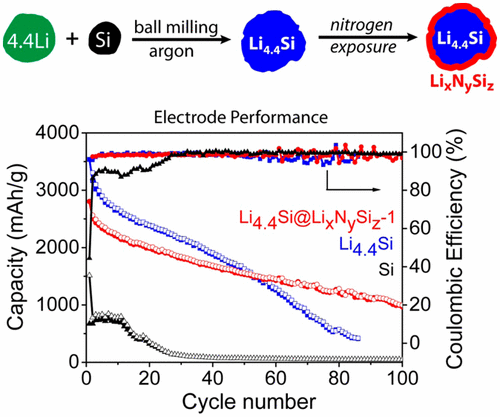当前位置:
X-MOL 学术
›
ACS Appl. Mater. Interfaces
›
论文详情
Our official English website, www.x-mol.net, welcomes your
feedback! (Note: you will need to create a separate account there.)
Study of Lithium Silicide Nanoparticles as Anode Materials for Advanced Lithium Ion Batteries
ACS Applied Materials & Interfaces ( IF 8.3 ) Pub Date : 2017-04-28 00:00:00 , DOI: 10.1021/acsami.6b16773 Xuemin Li 1 , Faith E. Kersey-Bronec 1 , John Ke 1 , Jacqueline E. Cloud 1 , Yonglong Wang 1 , Chilan Ngo 1 , Svitlana Pylypenko 1 , Yongan Yang 1
ACS Applied Materials & Interfaces ( IF 8.3 ) Pub Date : 2017-04-28 00:00:00 , DOI: 10.1021/acsami.6b16773 Xuemin Li 1 , Faith E. Kersey-Bronec 1 , John Ke 1 , Jacqueline E. Cloud 1 , Yonglong Wang 1 , Chilan Ngo 1 , Svitlana Pylypenko 1 , Yongan Yang 1
Affiliation

|
The development of high-performance silicon anodes for the next generation of lithium ion batteries (LIBs) evokes increasing interest in studying its lithiated counterpart—lithium silicide (LixSi). In this paper we report a systematic study of three thermodynamically stable phases of LixSi (x = 4.4, 3.75, and 2.33) plus nitride-protected Li4.4Si, which are synthesized via the high-energy ball-milling technique. All three LixSi phases show improved performance over that of unmodified Si, where Li4.4Si demonstrates optimum performance with a discharging capacity of 3306 (mA h)/g initially and maintains above 2100 (mA h)/g for over 30 cycles and above 1200 (mA h)/g for over 60 cycles at the current density of 358 mA/g of Si. A fundamental question studied is whether different electrochemical paradigms, that is, delithiation first or lithiation first, influence the electrode performance. No significant difference in electrode performance is observed. When a nitride layer (LixNySiz) is created on the surface of Li4.4Si, the cyclability is improved to retain the capacity above 1200 (mA h)/g for more than 80 cycles. By increasing the nitridation extent, the capacity retention is improved significantly from the average decrease of 1.06% per cycle to 0.15% per cycle, while the initial discharge capacity decreases due to the inactivity of Si in the LixNySiz layer. Moreover, the Coulombic efficiencies of all LixSi-based electrodes in the first cycle are significantly higher than that of a Si electrode (∼90% vs 40–70%).
中文翻译:

硅化锂纳米粒子作为高级锂离子电池负极材料的研究
用于下一代锂离子电池(LIB)的高性能硅阳极的开发引起了人们对其研究锂化硅化锂(Li x Si)的兴趣。在本文中,我们报告了通过高能球磨技术合成的Li x Si的三个热力学稳定相(x = 4.4、3.75和2.33)以及氮化物保护的Li 4.4 Si的系统研究。Li x Si的所有三个相均表现出比未改性的Si更高的性能,其中Li 4.4Si表现出最佳性能,最初的放电容量为3306(mA h)/ g,并在358的电流密度下保持超过2100(mA h)/ g超过30个循环,并保持超过1200(mA h)/ g超过60个循环。 mA / g的Si。研究的一个基本问题是,不同的电化学范例(即先进行脱锂还是先进行锂化)是否会影响电极性能。没有观察到电极性能的显着差异。在Li 4.4的表面上形成氮化物层(Li x N y Si z)时Si,提高了可循环性,以在超过80个循环中保持高于1200(mA h)/ g的容量。通过增加氮化程度,容量保持率从每周期的平均下降1.06%到每周期的0.15%显着提高,而初始放电容量由于Li x N y Si z层中Si的惰性而下降。此外,在第一个循环中,所有基于Li x Si的电极的库仑效率均显着高于Si电极(约90%对40-70%)。
更新日期:2017-05-04
中文翻译:

硅化锂纳米粒子作为高级锂离子电池负极材料的研究
用于下一代锂离子电池(LIB)的高性能硅阳极的开发引起了人们对其研究锂化硅化锂(Li x Si)的兴趣。在本文中,我们报告了通过高能球磨技术合成的Li x Si的三个热力学稳定相(x = 4.4、3.75和2.33)以及氮化物保护的Li 4.4 Si的系统研究。Li x Si的所有三个相均表现出比未改性的Si更高的性能,其中Li 4.4Si表现出最佳性能,最初的放电容量为3306(mA h)/ g,并在358的电流密度下保持超过2100(mA h)/ g超过30个循环,并保持超过1200(mA h)/ g超过60个循环。 mA / g的Si。研究的一个基本问题是,不同的电化学范例(即先进行脱锂还是先进行锂化)是否会影响电极性能。没有观察到电极性能的显着差异。在Li 4.4的表面上形成氮化物层(Li x N y Si z)时Si,提高了可循环性,以在超过80个循环中保持高于1200(mA h)/ g的容量。通过增加氮化程度,容量保持率从每周期的平均下降1.06%到每周期的0.15%显着提高,而初始放电容量由于Li x N y Si z层中Si的惰性而下降。此外,在第一个循环中,所有基于Li x Si的电极的库仑效率均显着高于Si电极(约90%对40-70%)。

































 京公网安备 11010802027423号
京公网安备 11010802027423号